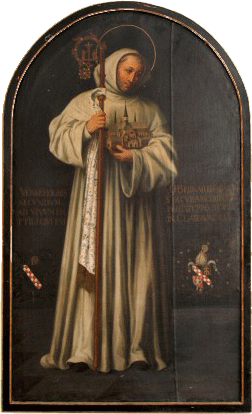Benedict of Nursia (* around 480; †547) founded the monastery near Montecassino in 529 and wrote the Regula Benedicti (Benedict's Rule) named after him. In addition to the well-known ora et labora, the turn to community life was an essential factor for a functioning monastic life. The Benedictines were the first actual order in the history of Western monasticism.
Over the next centuries, many Benedictine monasteries were founded. For example, Boniface (*673; †754), the "Apostle of the Germans", founded the monastery of Fulda in 744, in which only the Regula Benedicti was expressly to apply.
Through the later integration into the imperial administration, the large monasteries became more and more powerful, which undermined the ideal of poverty.
A monastic reform was necessary. It began on 11 September 910 with the foundation of Cluny Abbey by William of Aquitaine. The idea of reform with a strong emphasis on the liturgy spread rapidly in the West. Many monasteries joined Cluny and within a century the Cluny monastic federation comprised over a thousand monasteries.
However, the way of life of the monks of Cluny soon aroused criticism. The balance of prayer and manual labour provided for in the Rule of Benedict was softened in favour of prayer. The abbey lived on Mass stipends and prayer endowments. In its heyday during the 11th century, over 200 psalms were prayed daily by 400 monks at Cluny. Their masses and processions were the most magnificent within the church. In the monastery of Hirsau, which belonged to the federation, Abbot William († 1091) invented the status of the converse, which freed the monks even more from the necessity of manual labour.
Criticism of the Cluny way of life increased. Robert of Molesme founded a reform abbey at Molesme, where the monks were to live faithfully according to the Benedictine rule and earn their living by manual labour rather than by mass stipends and endowments. This attempt failed. A second attempt, however, succeeded. In 1098, a so-called "new monastery" was built near Dijon. The field name is Cîteaux, Latin cistercium. Robert became the first abbot, and under his successors Alberich of Cîteaux and Stephan Harding it became the mother monastery of the Cistercian Order.
The Cistercians contrasted the publicly celebrated prayer life of the Benedictines with solitude, poverty and physical labour. They consciously returned to a simple liturgy.

At the top of the list is: simplicity. They are against the accumulation of power and wealth, against processions, against magnificent church buildings and for the faithful observance of the rules of St. Benedict of Nursia.
The emphasis is on prayer, fasting and work. The outward sign is robes made of rough, undyed wool.
Stephan Harding and Berhard of Clairvaux (1090-1153) are the most important promoters. Within a few decades they succeed in founding hundreds of branches throughout Europe, including Switzerland.
With his brother Gerhard, Bernard of Clairvaux founded the famous monastery in Clairvaux in 1115 - in what is now the Outre-Aube district of Longchamp-sur-Aujon.
There is no hierarchical monastic structure, but a filial structure (mother monastery - daughter monastery). There are 4 primary abbeys one of which is in Cîteaux. The democratic structure culminates in the annual general chapter (similar to a European parliament).
The monasteries were founded far from human settlements, in lonely, uncultivated terrain near a river, and were usually associated with clearing.
The return to the simple monastic life according to the rules of St. Benedict also meant that the livelihood of a monastery was no longer to be earned by countless dependent peasants as with the Cluniac monks, but solely with the monastic community's own hands (self-management).
Thus a monastery's own agricultural business structure with monastery-owned workshops came into being.
Cover picture: Cloister in Lilienfeld Abbey